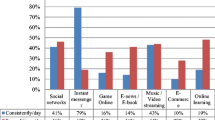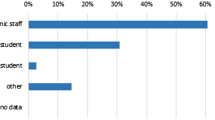Abstract
Advances in technology present multiple modes by which parents and teachers can now communicate. This article examines a new approach that a child care program adopted to document and share daily activities of individual children, including their development, while making this information accessible to the child’s parents, using a Childcare Management Software (CMS) mobile application (app). Using a mixed methods approach, data was collected from both teachers and parents through a Qualtrics (Qualtrics, Provo, UT) survey to examine how parents perceive the role of technology in communicating with early childhood teachers. Survey results revealed that the incorporation of the CMS app has become an effective communication tool to help track children’s developmental needs at the early childhood center and to communicate children’s daily activities with parents. However, the findings also indicate a need for CMS app training for teachers and parents to make efficient use of the mobile application.
Similar content being viewed by others
Data availability
Data and materials are available from the corresponding author on reasonable request.
Code availability
Codes are available from the corresponding author on reasonable request.
References
Bacigalupa, C. (2015). Partnering with families through photo collages. Early Childhood Education Journal, 44(4), 317–323
Bandura, A. (1997). Self-efficacy: The exercise of control. Freeman.
Creswell, J. W. (2014). Research design: Qualitative, quantitative, and mixed methods approaches. (4th ed.). Sage Press.
Demski, J. (2011). ELL to go. Technical Horizons in Education Journal, 38(5), 28–32
Gauvreau, A. N. (2015). How was your day in preschool? Teaching accurate recall using mobile technologies and visual supports (Doctoral dissertation). Available from ProQuest Dissertations (UMI No. 3723991).
Gauvreau, A. N., & Sandall, S. (2019). Using mobile technologies to communicate with parents and caregivers. Young Exceptional Children, 22(3), 115–126. https://doi.org/10.1177/1096250617726530
Glaser, B. G., & Strauss, A. L. (1967). The discovery of grounded theory: Strategies for qualitative research. Aldine.
Goodall, J. (2016). Technology and school-home communication. International Journal of Pedagogies and Learning, 11(2), 118–131
Hitlin, P. (2018). Internet, social media use and device ownership in U.S. have plateaued after years of growth. Retrieved from: https://www.pewresearch.org/fact-tank/2018/09/28/internet-social-media-use-and-device-ownership-in-u-s-have-plateaued-after-years-of-growth/
Lindgren, A. L. (2012). Ethical issue in pedagogical documentation: Representations of children through digital technology. International Journal of Early Childhood, 44(3), 327–340. https://doi.org/10.1007/s13158-012-0074-x.
Malaguzzi, L. (1998). History, ideas and basic philosophy: An interview with Lella Gandini. In G. Edwards (Ed.), & Forman, The hundred languages of children: The Reggio Emilia approach to early childhood education. (pp. 49–97). Ablex Pub. Corp.
Meadan, H., Ostrosky, M. M., Triplett, B., Michna, A., & Fettig, A. (2011). Using visual supports with young children with autism spectrum disorder. Teaching Exceptional Children, 43(6), 28–34
McNaughton, D., & Light, J. (2013). The iPad and mobile technology revolution: Benefits and challenges for individuals who require augmentative and alternative communication. Augmentative and Alternative communication, 29(2), 107–116. https://doi.org/10.3109/07434618.2013.784930
McGrath, W. H. (2003). Ambivalent partners: Relationships between mothers and teachers in a full-time child care center. Unpublished doctoral dissertation, University of Pennsylvania, PA.
National Association for the Education of Young Children [NAEYC]. (2012). Technology and interactive media as tools in early childhood programs serving children from birth through age 8. Retrieved from: https://www.naeyc.org/resources/topics/technology-and-media/preschoolers-and-kindergartners
Association, N., & for the Education of Young Children & Fred Rogers Center for Early Learning and Children’s Media. (2012). Technology and interactive media as tools in early childhood programs serving children from birth through age 8 (Joint Position Statement). Author.
Olmstead, C. (2013). Using technology to increase parent involvement in schools. TechTrends, 57(6), 28–37. https://doi.org/10.1007/s11528-013-0699-0
Parnell, W., & Bartlett, J. (2012). iDocument: How smartphones and tablets are changing documentation in preschool and primary classrooms. Young Children, 67(3), 50–59
Perrin, A., & Jiang, J. About a quarter of U.S. adults say they are ‘almost constantly’ online. Pew Research Center, Washington, D.C. (March 14, 2018). Retreived from: https://www.pewresearch.org/fact-tank/2018/03/14/about-a-quarter-of-americans-report-going-online-almost-constantly/
Schiller, John. (2003). Working with ICT perceptions of Australian principals. Journal of Educational Administration, 41(2), 171–185.
Strauss, A. (1987). Qualitative analysis for social scientists. Cambridge University Press.
Thompson, C. B., Mazer, J. P., & Grady, E. F. (2015). The changing nature of parent-teacher communication: Mode selection in the smartphone era. Communication Education, 64(2), 187–207. https://doi.org/10.1080/03634523.2015.1014382
Funding
The authors declare that there was no funding support this research.
Author information
Authors and Affiliations
Contributions
TX created the survey instrument and delivered the survey to participants. TX collected all data, analyzed, and interpreted the participants’ data, write the results and was a major contributor in writing the manuscript. AA contributed to literature review, assisted the design of survey questions, and the data analysis. BF assisted the design of survey questions and the data analysis. All authors read and approved the final manuscript.
Corresponding author
Ethics declarations
Ethics approval
This study is approved by Institutional Review Boards, file number is # 2019–1078.
Consent to participate
Consent forms are available from the corresponding author on reasonable request.
Consent for publication
Education and Information Technologies Journal has the consent to publish this manuscript.
Competing interests
The authors declare that they have no competing interests.
Additional information
Publisher's Note
Springer Nature remains neutral with regard to jurisdictional claims in published maps and institutional affiliations.
Rights and permissions
About this article
Cite this article
Xu, T., Akerson, A. & Fox, B. Incorporating technology to foster effective communication and documentation in child care programs. Educ Inf Technol 26, 5685–5695 (2021). https://doi.org/10.1007/s10639-021-10561-9
Received:
Accepted:
Published:
Issue Date:
DOI: https://doi.org/10.1007/s10639-021-10561-9




